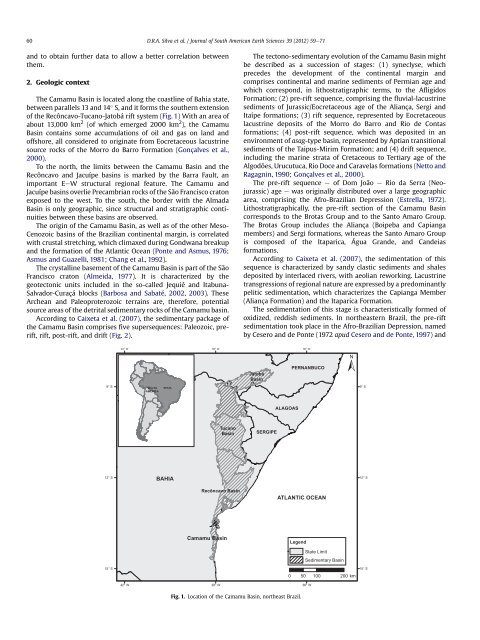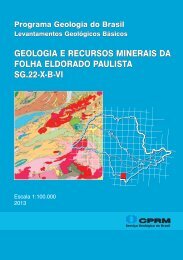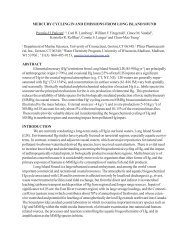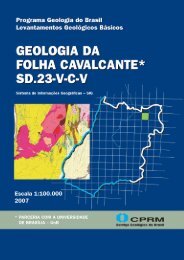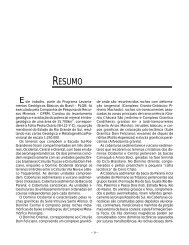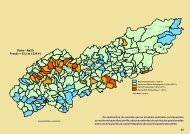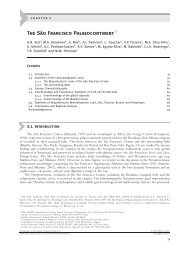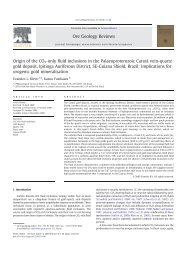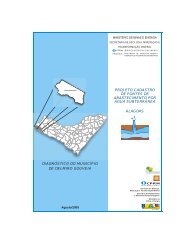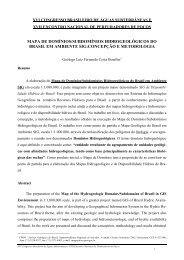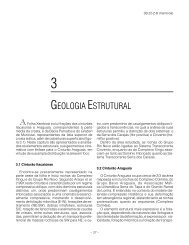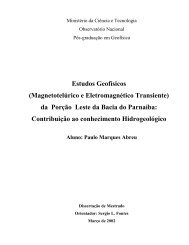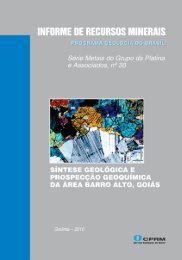Whole-rock geochemistry and Sr-Nd isotopic composition of ... - CPRM
Whole-rock geochemistry and Sr-Nd isotopic composition of ... - CPRM
Whole-rock geochemistry and Sr-Nd isotopic composition of ... - CPRM
You also want an ePaper? Increase the reach of your titles
YUMPU automatically turns print PDFs into web optimized ePapers that Google loves.
60<br />
<strong>and</strong> to obtain further data to allow a better correlation between<br />
them.<br />
2. Geologic context<br />
The Camamu Basin is located along the coastline <strong>of</strong> Bahia state,<br />
between parallels 13 <strong>and</strong> 14 S, <strong>and</strong> it forms the southern extension<br />
<strong>of</strong> the Recôncavo-Tucano-Jatobá rift system (Fig. 1) With an area <strong>of</strong><br />
about 13,000 km 2 (<strong>of</strong> which emerged 2000 km 2 ), the Camamu<br />
Basin contains some accumulations <strong>of</strong> oil <strong>and</strong> gas on l<strong>and</strong> <strong>and</strong><br />
<strong>of</strong>fshore, all considered to originate from Eocretaceous lacustrine<br />
source <strong>rock</strong>s <strong>of</strong> the Morro do Barro Formation (Gonçalves et al.,<br />
2000).<br />
To the north, the limits between the Camamu Basin <strong>and</strong> the<br />
Recôncavo <strong>and</strong> Jacuípe basins is marked by the Barra Fault, an<br />
important EeW structural regional feature. The Camamu <strong>and</strong><br />
Jacuípe basins overlie Precambrian <strong>rock</strong>s <strong>of</strong> the São Francisco craton<br />
exposed to the west. To the south, the border with the Almada<br />
Basin is only geographic, since structural <strong>and</strong> stratigraphic continuities<br />
between these basins are observed.<br />
The origin <strong>of</strong> the Camamu Basin, as well as <strong>of</strong> the other Meso-<br />
Cenozoic basins <strong>of</strong> the Brazilian continental margin, is correlated<br />
with crustal stretching, which climaxed during Gondwana breakup<br />
<strong>and</strong> the formation <strong>of</strong> the Atlantic Ocean (Ponte <strong>and</strong> Asmus, 1976;<br />
Asmus <strong>and</strong> Guazelli, 1981; Chang et al., 1992).<br />
The crystalline basement <strong>of</strong> the Camamu Basin is part <strong>of</strong> the São<br />
Francisco craton (Almeida, 1977). It is characterized by the<br />
geotectonic units included in the so-called Jequié <strong>and</strong> Itabuna-<br />
Salvador-Curaçá blocks (Barbosa <strong>and</strong> Sabaté, 2002, 2003). These<br />
Archean <strong>and</strong> Paleoproterozoic terrains are, therefore, potential<br />
source areas <strong>of</strong> the detrital sedimentary <strong>rock</strong>s <strong>of</strong> the Camamu basin.<br />
According to Caixeta et al. (2007), the sedimentary package <strong>of</strong><br />
the Camamu Basin comprises five supersequences: Paleozoic, prerift,<br />
rift, post-rift, <strong>and</strong> drift (Fig. 2).<br />
D.R.A. Silva et al. / Journal <strong>of</strong> South American Earth Sciences 39 (2012) 59e71<br />
Fig. 1. Location <strong>of</strong> the Camamu Basin, northeast Brazil.<br />
The tectono-sedimentary evolution <strong>of</strong> the Camamu Basin might<br />
be described as a succession <strong>of</strong> stages: (1) syneclyse, which<br />
precedes the development <strong>of</strong> the continental margin <strong>and</strong><br />
comprises continental <strong>and</strong> marine sediments <strong>of</strong> Permian age <strong>and</strong><br />
which correspond, in lithostratigraphic terms, to the Afligidos<br />
Formation; (2) pre-rift sequence, comprising the fluvial-lacustrine<br />
sediments <strong>of</strong> Jurassic/Eocretaceous age <strong>of</strong> the Aliança, Sergi <strong>and</strong><br />
Itaípe formations; (3) rift sequence, represented by Eocretaceous<br />
lacustrine deposits <strong>of</strong> the Morro do Barro <strong>and</strong> Rio de Contas<br />
formations; (4) post-rift sequence, which was deposited in an<br />
environment <strong>of</strong> asag-type basin, represented by Aptian transitional<br />
sediments <strong>of</strong> the Taipus-Mirim Formation; <strong>and</strong> (4) drift sequence,<br />
including the marine strata <strong>of</strong> Cretaceous to Tertiary age <strong>of</strong> the<br />
Algodões, Urucutuca, Rio Doce <strong>and</strong> Caravelas formations (Netto <strong>and</strong><br />
Ragagnin, 1990; Gonçalves et al., 2000).<br />
The pre-rift sequence e <strong>of</strong> Dom João e Rio da Serra (Neojurassic)<br />
age e was originally distributed over a large geographic<br />
area, comprising the Afro-Brazilian Depression (Estrella, 1972).<br />
Lithostratigraphically, the pre-rift section <strong>of</strong> the Camamu Basin<br />
corresponds to the Brotas Group <strong>and</strong> to the Santo Amaro Group.<br />
The Brotas Group includes the Aliança (Boipeba <strong>and</strong> Capianga<br />
members) <strong>and</strong> Sergi formations, whereas the Santo Amaro Group<br />
is composed <strong>of</strong> the Itaparica, Água Gr<strong>and</strong>e, <strong>and</strong> C<strong>and</strong>eias<br />
formations.<br />
According to Caixeta et al. (2007), the sedimentation <strong>of</strong> this<br />
sequence is characterized by s<strong>and</strong>y clastic sediments <strong>and</strong> shales<br />
deposited by interlaced rivers, with aeolian reworking. Lacustrine<br />
transgressions <strong>of</strong> regional nature are expressed by a predominantly<br />
pelitic sedimentation, which characterizes the Capianga Member<br />
(Aliança Formation) <strong>and</strong> the Itaparica Formation.<br />
The sedimentation <strong>of</strong> this stage is characteristically formed <strong>of</strong><br />
oxidized, reddish sediments. In northeastern Brazil, the pre-rift<br />
sedimentation took place in the Afro-Brazilian Depression, named<br />
by Cesero <strong>and</strong> de Ponte (1972 apud Cesero <strong>and</strong> de Ponte, 1997) <strong>and</strong>


